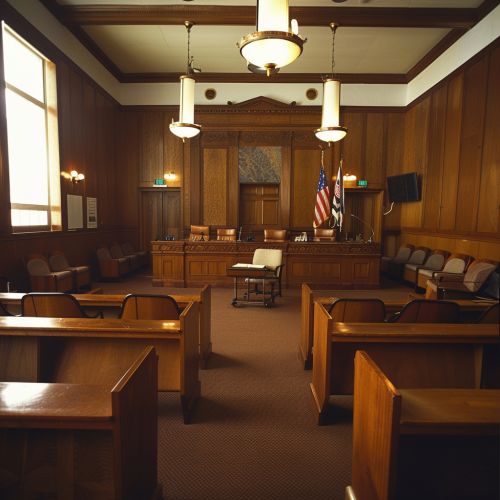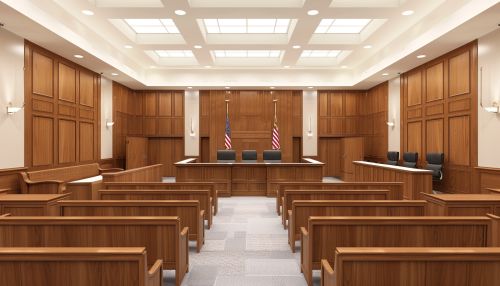Class Action: Difference between revisions
(Created page with "== Introduction == A '''class action''', also known as a '''class lawsuit''', '''class suit''', or '''representative action''', is a type of lawsuit where one of the parties is a group of people who are represented collectively by a member of that group. This form of litigation is prevalent in the United States but is also found in other jurisdictions. Class actions are a crucial mechanism in the legal system, allowing for the efficient resolution of claims that affect l...") |
No edit summary |
||
| Line 70: | Line 70: | ||
Class actions play a vital role in the legal system, providing a mechanism for addressing collective harm and promoting accountability. While they have their challenges and criticisms, ongoing reforms aim to enhance their effectiveness and fairness. | Class actions play a vital role in the legal system, providing a mechanism for addressing collective harm and promoting accountability. While they have their challenges and criticisms, ongoing reforms aim to enhance their effectiveness and fairness. | ||
[[Image:Detail-96999.jpg|thumb|center|Interior of a courtroom with a judge's bench, witness stand, and seating for the jury and public.|class=only_on_mobile]] | |||
[[Image:Detail-97000.jpg|thumb|center|Interior of a courtroom with a judge's bench, witness stand, and seating for the jury and public.|class=only_on_desktop]] | |||
== See Also == | == See Also == | ||
Latest revision as of 08:32, 16 July 2024
Introduction
A class action, also known as a class lawsuit, class suit, or representative action, is a type of lawsuit where one of the parties is a group of people who are represented collectively by a member of that group. This form of litigation is prevalent in the United States but is also found in other jurisdictions. Class actions are a crucial mechanism in the legal system, allowing for the efficient resolution of claims that affect large numbers of individuals.
History
The origins of class action lawsuits can be traced back to the English Court of Chancery in the 17th century. The modern form of class action litigation, however, emerged in the United States with the adoption of Rule 23 of the Federal Rules of Civil Procedure in 1938. This rule was significantly revised in 1966 to make class actions more accessible and effective.
Legal Framework
United States
In the United States, class actions are governed by Rule 23 of the Federal Rules of Civil Procedure. This rule outlines the prerequisites for a class action, including numerosity, commonality, typicality, and adequacy of representation. Additionally, the Class Action Fairness Act of 2005 (CAFA) expanded federal jurisdiction over many large class-action lawsuits and mass actions.
International Perspectives
Class action mechanisms vary significantly across jurisdictions. In Canada, for example, each province has its own rules governing class actions, with Ontario's Class Proceedings Act, 1992 being one of the most influential. In the European Union, collective redress mechanisms are less developed, but recent directives aim to harmonize and enhance these procedures across member states.
Types of Class Actions
Class actions can be categorized based on the nature of the claims and the relief sought. Common types include:
Consumer Class Actions
These involve claims by consumers against companies for issues such as defective products, false advertising, and unfair business practices.
Securities Class Actions
These are brought by investors who have suffered financial losses due to corporate fraud or misrepresentation.
Employment Class Actions
These involve claims by employees against employers for issues such as wage and hour violations, discrimination, and wrongful termination.
Environmental Class Actions
These are brought by individuals or groups affected by environmental harm, such as pollution or toxic exposure.
Procedure
The procedure for initiating and conducting a class action involves several key steps:
Filing the Complaint
A class action begins with the filing of a complaint by the lead plaintiff, who represents the interests of the entire class.
Class Certification
The court must certify the class, determining that it meets the prerequisites outlined in Rule 23. This involves a rigorous analysis of the numerosity, commonality, typicality, and adequacy of representation.
Notice to Class Members
Once the class is certified, notice must be given to all potential class members, informing them of the lawsuit and their rights, including the option to opt-out.
Discovery and Pre-Trial Motions
The discovery process involves the exchange of information between the parties. Pre-trial motions may include motions to dismiss, motions for summary judgment, and motions to decertify the class.
Settlement or Trial
Many class actions are resolved through settlement, which must be approved by the court to ensure it is fair, reasonable, and adequate. If the case goes to trial, the court or jury will determine the outcome.
Advantages and Disadvantages
Advantages
Class actions offer several advantages, including judicial efficiency, the ability to address widespread harm, and the provision of a remedy for individuals who might not have the resources to pursue individual claims.
Disadvantages
However, class actions also have drawbacks. They can be complex and time-consuming, and the interests of individual class members may not always align with those of the lead plaintiff or class counsel. Additionally, settlements may result in minimal compensation for class members while providing substantial fees for attorneys.
Notable Class Actions
Several class actions have had significant legal and societal impacts:
Brown v. Board of Education
This landmark case led to the desegregation of public schools in the United States.
In re Enron Corp. Securities, Derivative & "ERISA" Litigation
This case involved claims by investors who suffered losses due to the collapse of Enron Corporation.
Dukes v. Wal-Mart Stores, Inc.
This employment discrimination case was notable for its size and the Supreme Court's decision on class certification standards.
Criticisms and Reforms
Class actions have faced criticism for being prone to abuse, with concerns about frivolous lawsuits, excessive attorney fees, and inadequate compensation for class members. Reforms such as the Class Action Fairness Act of 2005 have sought to address these issues by enhancing judicial oversight and promoting fairness in settlements.
Conclusion
Class actions play a vital role in the legal system, providing a mechanism for addressing collective harm and promoting accountability. While they have their challenges and criticisms, ongoing reforms aim to enhance their effectiveness and fairness.


